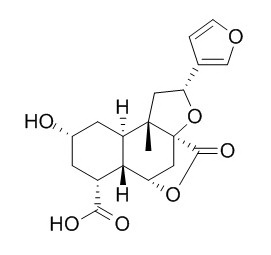Diosbulbin C
Diosbulbin C has hepatotoxicity.
Inquire / Order:
manager@chemfaces.com
Technical Inquiries:
service@chemfaces.com
Tel:
+86-27-84237783
Fax:
+86-27-84254680
Address:
1 Building, No. 83, CheCheng Rd., Wuhan Economic and Technological Development Zone, Wuhan, Hubei 430056, PRC
Providing storage is as stated on the product vial and the vial is kept tightly sealed, the product can be stored for up to
24 months(2-8C).
Wherever possible, you should prepare and use solutions on the same day. However, if you need to make up stock solutions in advance, we recommend that you store the solution as aliquots in tightly sealed vials at -20C. Generally, these will be useable for up to two weeks. Before use, and prior to opening the vial we recommend that you allow your product to equilibrate to room temperature for at least 1 hour.
Need more advice on solubility, usage and handling? Please email to: service@chemfaces.com
The packaging of the product may have turned upside down during transportation, resulting in the natural compounds adhering to the neck or cap of the vial. take the vial out of its packaging and gently shake to let the compounds fall to the bottom of the vial. for liquid products, centrifuge at 200-500 RPM to gather the liquid at the bottom of the vial. try to avoid loss or contamination during handling.
J Plant Biotechnol.2023, 50:070-075.
Biomedicine & Pharmacotherapy2022, 153:113404.
Food Funct.2022, doi: 10.1039
Nutr Cancer.2023, 75(1):376-387.
Mol Med Rep.2015, 12(5):7789-95
Korean J. of Horticultural Sci. & Tech. 2017, 793-804
Nutrients.2023, 15(12):2810.
Foods.2022, 11(12):1708.
RSC Advances2017, 86
Biochem Pharmacol.2020, 178:114083
Related and Featured Products
Chemical Research in Toxicology, 2018,31(9):843-851.
An integrated metabolomics and proteomics approach to identify metabolic abnormalities in rats with Dioscorea bulbifera rhizome-induced hepatotoxicity.[Reference:
WebLink]
It is vital to monitor the holistic toxicokinetics of toxic Chinese herbal medicines (CHMs) for safety. Although an integrated strategy based on the area under the curve (AUC) has been proposed to characterize the pharmacokinetic/toxicokinetic properties of CHMs, improvement is still needed.
METHODS AND RESULTS:
This study attempted to use 50% inhibitory concentration (IC50) as weighting coefficient to investigate holistic toxicokinetics of the major diosbulbins i.e. diosbulbin A (DA), diosbulbin B (DB), and Diosbulbin C (DC) after oral administration of Dioscorea bulbifera rhizome (DBR) extract. Firstly, the cytotoxicities of the three diosbulbins on human hepatic L02 cells were evaluated and the IC50 values were calculated. Then, integrated toxicokinetics of multiple diosbulbins based on AUC and IC50 were determined. Finally, correlations between integrated plasma concentrations and hepatic injury biomarkers including alanine aminotransferase (ALT), aspartate aminotransferase (AST), alkaline phosphatase (ALP), and total bile acid (TBA) were analyzed. As a result, integrated plasma concentrations were correlated well with TBA and the correlation between TBA and IC50-weighting integrated plasma concentrations was better than that of AUC-weighting integrated plasma concentrations.
CONCLUSIONS:
In conclusion, the newly developed IC50-weighting method is expected to generate more reasonable integrated toxicokinetic parameters, which will help to guide the safe usage of DBR in clinical settings.



